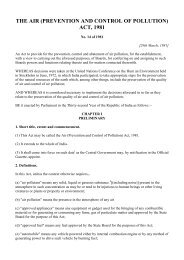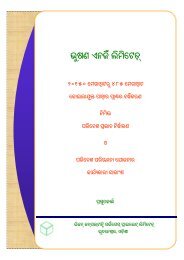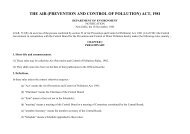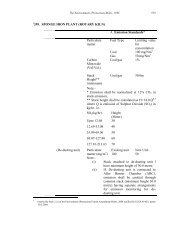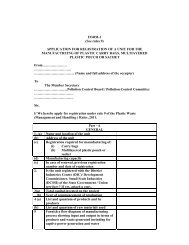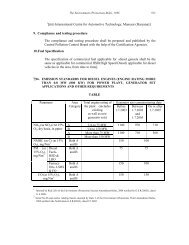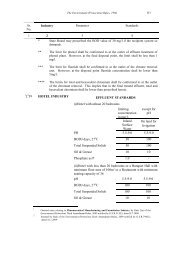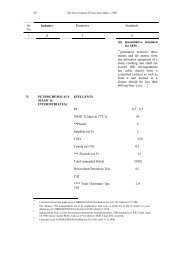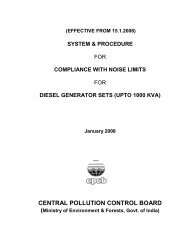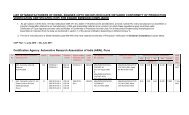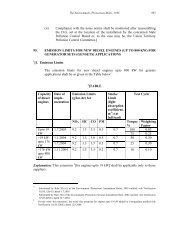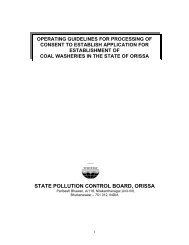EIA/EMP Report of Beneficiation Plant –BRPL - State Pollution ...
EIA/EMP Report of Beneficiation Plant –BRPL - State Pollution ...
EIA/EMP Report of Beneficiation Plant –BRPL - State Pollution ...
Create successful ePaper yourself
Turn your PDF publications into a flip-book with our unique Google optimized e-Paper software.
EXECUTIVE SUMMARY<br />
0.1 INTRODUCTION<br />
S.S.Environics (India) Pvt. Ltd.<br />
<strong>EIA</strong>/<strong>EMP</strong> <strong>Report</strong> <strong>of</strong> <strong>Beneficiation</strong> <strong>Plant</strong> <strong>–BRPL</strong><br />
M/s Brahmani River Pellets Limited (thereafter referred as BRPL) proposes<br />
to commission a beneficiation plant near Bhadrasahi chowk in village Tonto,<br />
Barbil tehsil, Keonjhar district, Orissa to produce concentrated iron ore fines @<br />
4.0 million tones per annum.<br />
The proposed project shall not have any captive iron ore mine and shall be based<br />
only on the iron ore fines generated/to be generated by the various iron ore<br />
mines operative in the area. The proposed beneficiation plant shall have<br />
following major components:<br />
• <strong>Beneficiation</strong> plant at Tonto village;<br />
• Tailing Dam at Nalda village;<br />
• Belt conveyor for transportation <strong>of</strong> iron ore from mines;<br />
• A pipeline (12 inch in diameter and 230.5 km in length) to proposed Pellets<br />
plant in Kalingnagar Industrial Complex Sukinda tehsil, Jajpur district, Orissa,<br />
for transportation <strong>of</strong> beneficiated iron ore;<br />
• 15.375 km rubber lined pipeline <strong>of</strong> 8 inch in diameter to tailing dam for tailing<br />
discharge; and<br />
• 18.92 km pipeline <strong>of</strong> 12 inch in diameter for water supply from Baitarini river.<br />
Proposed beneficiation plant and tailing dam have Latitude: 22 o 02' 36” N &<br />
Longitude: 85 o 22' 10” E and Latitude: 22 o 09' 47” N & Longitude: 85 o 24' 35”<br />
E respectively (as per Survey <strong>of</strong> India toposheet no. 73 F/8, scale 1:50000). The<br />
accessibility to site is as per hereunder:<br />
• Road: The beneficiation plant site is just beside NH-215.<br />
• Rail: The nearest railway station is at Barbil, which is about 6.5 km from the<br />
beneficiation plant site and is located on the Howrah-Barbil section <strong>of</strong> South<br />
Eastern Railway.<br />
• Air: The nearest airport is at Bhubaneswar, which is about 300 km from<br />
beneficiation plant site and well connected by road.<br />
The proposed project is designated to be developed under the Environmental<br />
Impact Assessment (<strong>EIA</strong>) Notification and amendments under Environment<br />
(Protection) Act (EPA), 1986. Proposed project falls under “Category A” as per<br />
the notification issued on 14 th September 2006 by Ministry <strong>of</strong> Environment &<br />
Forests (MOEF) as new environment clearance procedure.<br />
i
S.S.Environics (India) Pvt. Ltd.<br />
<strong>EIA</strong>/<strong>EMP</strong> <strong>Report</strong> <strong>of</strong> <strong>Beneficiation</strong> <strong>Plant</strong> <strong>–BRPL</strong><br />
M/s S.S.Environics (India) Pvt. Ltd., (thereafter referred as SSE),<br />
Bhubaneswar, Orissa, has been retained by BRPL to carry out Environment<br />
Impact Assessment (<strong>EIA</strong>) study and to prepare Environment Management Plan<br />
(<strong>EMP</strong>) for the proposed project. The study has been carried out as per the Terms<br />
<strong>of</strong> Reference (TOR), issued by MOEF for carrying out the <strong>EIA</strong>/<strong>EMP</strong> study vide<br />
letter No J-11015/121/2007-IA.II (M) dated 29 th May 2007 (based on the duly<br />
filled Form 1 along with pre-feasibility report submitted and subsequent<br />
presentation made to MOEF) as the first step <strong>of</strong> the notification issued on 14 th<br />
September 2006.<br />
0.2 PROJECT DESCRIPTION<br />
� Land Requirement<br />
The details <strong>of</strong> land envisaged to be procured for the proposed project are as per<br />
given below:<br />
Sn Particulars Area (ha) Remarks<br />
1 <strong>Beneficiation</strong> <strong>Plant</strong> 44.53 • Private land- 3.49 ha<br />
• Government Land- 41.04 ha<br />
2 Tailing Dam 45.06 • Private land- 32.52 ha<br />
• Government Land- 12.54 ha<br />
3 Corridor for belt conveyor<br />
(Length:1.0 km & Width 5 m)<br />
0.5 Within MISL lease<br />
4 Pipeline for transportation <strong>of</strong> Iron<br />
Ore Slurry to Pellet plant<br />
(Length:230.50 km)<br />
5 Pipeline for water from Baitarini<br />
river (Length:18.92 km)<br />
6 Pipeline for transportation <strong>of</strong><br />
rejects to tailing<br />
dam(Length:15.375 km)<br />
Nil • All along the NH-215 and SH-<br />
20.<br />
Nil • All along the NH-215/Major<br />
District Road (MDR) /Other<br />
District Road (ODR )<br />
Nil • All along the NH- 215/MDR/<br />
ODR<br />
The details <strong>of</strong> existing land use pattern (as per revenue records) <strong>of</strong> the land<br />
proposed to be procured are as per given below:<br />
Sn Particulars<br />
Area (ha.)<br />
<strong>Plant</strong> Tailing Dam Corridor for Belt<br />
conveyor*<br />
Govt Pvt Govt Pvt Govt Pvt<br />
1 Jungle 27.10 0 12.54 0 0 0<br />
2 Gochar 6.25 0 0 0 0 0<br />
3 Grazing 0 0 0 0 0 0<br />
4 Road 0 0 0 0 0 0<br />
5 Waste 7.69 3.49 0 32.52 0.5 0<br />
6 Cultivated 0 0 0 0 0 0<br />
7 Residential 0 0 0 0 0 0<br />
Total 41.04 3.49 12.54 33.52 0.5 0.0<br />
* within MISL ML area<br />
ii
S.S.Environics (India) Pvt. Ltd.<br />
<strong>EIA</strong>/<strong>EMP</strong> <strong>Report</strong> <strong>of</strong> <strong>Beneficiation</strong> <strong>Plant</strong> <strong>–BRPL</strong><br />
Proposal for Stage –I clearance for jungle as forest land has been submitted to<br />
Chief Conservator <strong>of</strong> Forests (CCF) vide letter no HO-IDCO/DCF/FC/75-07-12158,<br />
dated 5.07.2007.<br />
The proposed land utilization plans are as per given below:<br />
Sn Particulars<br />
Area (hect.)<br />
<strong>Beneficiation</strong> <strong>Plant</strong> Tailing Dam<br />
1 <strong>Plant</strong>/Dam 5.790 34.56<br />
2 Storage <strong>of</strong> raw material 17.179 0.0<br />
3 Water reservoir 3.040 0.0<br />
4 Administrative Buildings 0.230 0.25<br />
5 Storage <strong>of</strong> fuel 0.0 0.0<br />
6 Greenbelt/plantation 15.391 10.25<br />
7 Others (conveyor corridor and road) 2.9 0.0<br />
Total 44.53 45.06<br />
� Raw Material<br />
Low grade (Fe – 60~63%) iron ore fines (-10mm) @ 4.75 million tpa shall be<br />
beneficiated to produce about 4.0 million tpa concentrate with an average grade<br />
<strong>of</strong> +64.5% Fe. Mine <strong>of</strong> Mideast Intergrated Steel Limited (MISL) at Roida shall be<br />
the major supplier <strong>of</strong> iron ore fines and shall fulfill about 50% <strong>of</strong> the<br />
requirement. The balance requirement <strong>of</strong> iron ore fines for the proposed<br />
beneficiation will be augmented from various mines located in Jamda - Koira<br />
valley <strong>of</strong> Bonai synclinorium located mainly at Joda, Koira & Roida sectors. The<br />
major sources are expected to be from Thakurani mines <strong>of</strong> Sesa Goa Ltd, Jajang,<br />
Oraghat, Tehri & Bico <strong>of</strong> Rungta Mines Ltd, Kasia <strong>of</strong> Essel Mining & Co Ltd &<br />
Bolani <strong>of</strong> SAIL.<br />
It is envisaged that iron ore fines @ 2.5mtpa from MISL mine and @1.0 mtpa<br />
from KN Ram mine for the proposed plant will be transported through belt<br />
conveyor) while @1.25 mtpa by roads. Considering 300 working days and 16<br />
tonnes per truck/dumpers, total number <strong>of</strong> trip to the plant shall be 260 per day.<br />
The maximum distance <strong>of</strong> any mine from where iron ore fines shall be procured<br />
is within 2 km.<br />
The traffic density <strong>of</strong> the NH215 will not increase due to the proposed trucks<br />
movement since the movements are restricted from mines to beneficiation plant<br />
and the movement shall be on purely internal hauling and shall cross NH215 at<br />
one point while transporting from KN Ram mine.<br />
� Manufacturing Process<br />
The pellet feed iron ore concentrate to be produced in the beneficiation plant<br />
must be 100% <strong>of</strong> minus 100 mesh (-150 micron) to meet slurry pipeline<br />
iii
S.S.Environics (India) Pvt. Ltd.<br />
<strong>EIA</strong>/<strong>EMP</strong> <strong>Report</strong> <strong>of</strong> <strong>Beneficiation</strong> <strong>Plant</strong> <strong>–BRPL</strong><br />
transportation system design criteria. The concentrate shall also have<br />
approximately 80% <strong>of</strong> (-) 325 mesh (- 45 micron) material and a nominal grade<br />
<strong>of</strong> 64.5% Fe to meet the pellet plant process requirement.<br />
Two identical beneficiation circuits, each with a capacity to produce 2 mio tpa <strong>of</strong><br />
iron ore concentrate are envisaged. <strong>Beneficiation</strong> process consists <strong>of</strong>:<br />
• Primary wet grinding;<br />
• Hydro cycloning;<br />
• Two stage spiral classification;<br />
• Single stage high gradient magnetic separation;<br />
• Regrinding and thickening <strong>of</strong> concentrate received from both spirals; and<br />
• Magnetic separators.<br />
The details <strong>of</strong> main machinery/equipment envisaged for the proposed beneficiation<br />
plant are as per given below:<br />
Sn Particulars Quantity Capacity<br />
1 Primary ball mill 2 330 tph (each)<br />
2 Primary Hydro cyclone (26” dia.) 10 100 tph (each)<br />
3 Primary spirals 308 starts -<br />
4 Cleaner spirals 228 starts -<br />
5 Secondary Hydro cyclone (10” dia.) 20 50 tph (each)<br />
6 Regrinding ball mill 2 230 tph (each)<br />
7 Linear screen 2 151.5 tph (each)<br />
8 Cone splitter 2 28 tph (each)<br />
9 HGMS 2 137.5 tph (each)<br />
10 Intermediate Thickener (55m dia.) 1 303 tph<br />
11 Concentrate Thickener (48m dia.) 1 558 tph<br />
12 Tailing Thickener (60m dia.) 1 98 tph<br />
13 EOT crane (Ball mill Bay) 2 60t/10t<br />
14 EOT crane (HGMS Bay) 2 12t/3t<br />
� Power<br />
Total power requirement during operation phase <strong>of</strong> the proposed beneficiation<br />
plant shall be 18.5 MW which is proposed to be obtained from the North Eastern<br />
Electricity Supply Company <strong>of</strong> Orissa Ltd. (NESCO). One standby Diesel<br />
Generator having a capacity <strong>of</strong> 750 KW is envisaged which shall be used in case<br />
<strong>of</strong> power failure only.<br />
0.3 ANTICIPATED ENVIRONMENT IMPACTS & MITIGATION MEASURES<br />
� Land Use Pattern<br />
About 59.81% <strong>of</strong> total land proposed to be acquired belongs to government land<br />
while rest <strong>of</strong> the land belongs to private land. About 44.25% <strong>of</strong> total land is<br />
designated as jungle as per local revenue records. No cultivated and grazing land<br />
iv
S.S.Environics (India) Pvt. Ltd.<br />
<strong>EIA</strong>/<strong>EMP</strong> <strong>Report</strong> <strong>of</strong> <strong>Beneficiation</strong> <strong>Plant</strong> <strong>–BRPL</strong><br />
is proposed to be acquired. Total area envisaged for the project is only 89.59<br />
hect, which is very small as compared to the total study area.<br />
Mitigation Measures<br />
• Forest clearance for land designated as jungles shall be obtained from MOEF<br />
before clearing the site.<br />
� Water Resources<br />
The maximum and average estimated water requirements during operation<br />
phase are 11520 m 3 /day (0.134 m 3 /s) and 7520 m 3 /day (0.087 m 3 /s)<br />
respectively which shall be drawn from the Baitarini river at Kanpur village. A<br />
water intake well and pumping station shall be provided on the bank <strong>of</strong> Baitarini<br />
river to draw the water and same shall be transported through a 18.92 km long<br />
pipeline to beneficiation plant site. It is evident from the data available <strong>of</strong> last 27<br />
years from the secondary sources for flow rate available in Baitarini river at<br />
Kanpur village that:<br />
• The minimum flow rate was less than 0.5 m 3 /s during the month December,<br />
February, Mach and April;<br />
• The minimum flow rate available was 0.16 m 3 /s during the month <strong>of</strong> April;<br />
and<br />
• During lean season, water availability shows a sign <strong>of</strong> uncertainty.<br />
Mitigation Measures<br />
• Excess water to be stored in the tailing dam shall be utilized during lean<br />
season;<br />
• Alternate sources shall be evaluated and considered; and<br />
• Regular record <strong>of</strong> water flow <strong>of</strong> Baitarini River shall be maintained.<br />
� Ambient Air Quality<br />
The proposed beneficiation process is a wet process and the potential particulate<br />
matter emission shall be limited to the raw material handling and conveying.<br />
Otherwise, all unit operations will be carried out in wet mode and in closed<br />
circuit. The details <strong>of</strong> anticipated air pollution and its management are as per<br />
given below:<br />
Sn Activity Type <strong>of</strong> Pollutants Management<br />
1 Transportation <strong>of</strong> iron ore fines<br />
By belt conveyor • Fugitive Dust • Belt conveyor shall be fully covered<br />
• Transfer points shall be provided with<br />
dedusting system such as bag filters<br />
with a outlet dust concentration <strong>of</strong> 50<br />
mg/Nm 3 .<br />
v
By trucks/<br />
dumpers<br />
2 Handling &<br />
storage at plant<br />
site<br />
3 Operation <strong>of</strong> DG<br />
set in case <strong>of</strong><br />
power failure<br />
S.S.Environics (India) Pvt. Ltd.<br />
• Dust<br />
• Dust, SO2, NOX &<br />
CO due to<br />
Vehicular<br />
movement<br />
<strong>EIA</strong>/<strong>EMP</strong> <strong>Report</strong> <strong>of</strong> <strong>Beneficiation</strong> <strong>Plant</strong> <strong>–BRPL</strong><br />
• Trucks shall be properly covered with<br />
tarpaulin<br />
• Preventive maintenance <strong>of</strong> vehicles<br />
• Fugitive Dust • Adequate arrangement for water spray<br />
shall be provided<br />
• Storage yard shall be properly fenced<br />
and bushes shall be planted at the<br />
periphery <strong>of</strong> yard<br />
• SPM, SO2, NOX &<br />
CO<br />
• Adequate stack height as per CPCB<br />
guidelines shall be provided<br />
Mitigation Measures<br />
In addition to mentioned above, other mitigation measures are as per given<br />
below:<br />
• Level sensor to have a gap <strong>of</strong> only half-meter in between stacking boom and<br />
top <strong>of</strong> pile;<br />
• <strong>Plant</strong> roads & approach roads shall be made <strong>of</strong> bitumen/ concrete; and<br />
• Effective house keeping shall be carried out.<br />
� Water Quality<br />
During beneficiation process, water shall be discharged via three different ways:<br />
o Along with tailings to tailing dam;<br />
o Along with beneficiated iron ore to pellet plant at Jajpur; and<br />
o As domestic waste water.<br />
It is envisaged that:<br />
• Tailings shall not contain any soluble mineral hence; overflow from dam shall<br />
be recycled back to process @ 2352 m 3 /day (max) and 1892 m 3 /day<br />
(average);<br />
• At pellet plant, water resulting from filtration <strong>of</strong> slurry shall be used for<br />
process and domestic usage after adequate treatment; and<br />
• Domestic waste water shall be generated @31m 3 /day. Primary and<br />
secondary treatment shall be provided to make treated water fit for irrigation<br />
purposes to be used for green belt development /plantation.<br />
In addition to above, water quality <strong>of</strong> the study area may get affected due to:<br />
1. Ground water quality due to leaching from tailing dam<br />
The sub soil investigation <strong>of</strong> the site allocated for tailing pond and on the axis <strong>of</strong><br />
the proposed earthen dam indicates that the top soil is <strong>of</strong> gray colored clay soil<br />
with gravel up to 1.5 m level form top. The permeability <strong>of</strong> soil is 4.21x10 -4<br />
cm/sec. The next layer consists <strong>of</strong> boulder mixed gravel up to 6.0m. There after,<br />
disintegrated rock strata is encountered.<br />
vi
S.S.Environics (India) Pvt. Ltd.<br />
<strong>EIA</strong>/<strong>EMP</strong> <strong>Report</strong> <strong>of</strong> <strong>Beneficiation</strong> <strong>Plant</strong> <strong>–BRPL</strong><br />
Local clay liner will be provided to check the seepage through tailing dam. The<br />
density <strong>of</strong> the clay liner will be achieved to the prescribed moister content <strong>of</strong><br />
± 3% which shall provide a permeability <strong>of</strong> 10 -6 to 10 -7 cm/sec. The dam<br />
foundation will be made impermeable as far as possible by cotton grouting. The<br />
leaching because <strong>of</strong> percussion through foundation is remote as the clay liner on<br />
the sides <strong>of</strong> the embankment with cotton grouting will provide an impermeable<br />
layer. Hence leaching due to seepage through dam is almost zero. Also the tailing<br />
thickener shall be made out <strong>of</strong> RCC structure connected to a full leak pro<strong>of</strong> under<br />
flow system leaves no scope <strong>of</strong> leaching.<br />
2. Surface water quality due to spill over the tailings along with storm<br />
water during monsoon season<br />
The catchments area <strong>of</strong> the tailing dam is almost a valley impounded from three<br />
sides and making the surface run<strong>of</strong>f discharge to the nearby Laskara nallah,<br />
which meets Karo river at a distance <strong>of</strong> 6km in northern site <strong>of</strong> the catchments.<br />
The topographical representation clearly indicates the limited run <strong>of</strong>f from the hill<br />
top to the valley.<br />
The average annual rainfall in the study area is about 1400 mm and considering<br />
the infiltration, evapotransporation and evaporation, the annual run <strong>of</strong>f shall be<br />
around 50 mm. Free board holding capacity <strong>of</strong> the tailing dam shall be<br />
considered on the basis <strong>of</strong> 250 mm run <strong>of</strong>f which is 5 times higher than the<br />
actual.<br />
The dam is designed to hold the rain water over the area <strong>of</strong> the dam only. No<br />
surface run <strong>of</strong>fs shall enter the dam from the catchment area, as retaining<br />
wall/toe walls shall be provided before the embankment <strong>of</strong> the tailing dam.<br />
In addition to sufficient free board taking into the run<strong>of</strong>f deposition, provision <strong>of</strong><br />
pumping back the excess water from the impounded catchments has been<br />
considered in designing the embankment structure <strong>of</strong> the dam.<br />
In design <strong>of</strong> the dam, provision <strong>of</strong> spillway is included to release excess<br />
rainwater. These spillways shall be designed as temporary structures (as raised<br />
embankment) with sufficient free board. The spillway will be designed to contain<br />
and control hydraulic jumps that occur at the bottom <strong>of</strong> the spillway.<br />
Hence, chances that may result in suspended solids and turbidity in run <strong>of</strong>f water<br />
during the monsoon period are remote.<br />
vii
S.S.Environics (India) Pvt. Ltd.<br />
<strong>EIA</strong>/<strong>EMP</strong> <strong>Report</strong> <strong>of</strong> <strong>Beneficiation</strong> <strong>Plant</strong> <strong>–BRPL</strong><br />
� Soil Quality<br />
The details <strong>of</strong> solid waste generated and its management are described<br />
hereunder:<br />
Sn Source Quantity Disposal<br />
1 Raw water treatment plant 72 m 3 /day Shall be used for filling <strong>of</strong> low lying area<br />
2 Tailings from thickener 0.7 mio tpa Shall be disposed <strong>of</strong>f in tailing dam<br />
3 Sewage Treatment <strong>Plant</strong> 4-5 kg/day Shall be used as manure for green belt<br />
development/plantation<br />
� Ecology<br />
The impact on the ecology <strong>of</strong> the study area during operation phase may<br />
account for the following:<br />
• Water availability to the downstream users <strong>of</strong> the Baitairni river with respect<br />
to withdrawal point at village Kanpur;<br />
• Tailing's spillover from tailing dam during monsoon season; and<br />
• Due to operation <strong>of</strong> project.<br />
As explained during the impact assessment on water resources on the basis <strong>of</strong><br />
last 27 years flow data <strong>of</strong> Baitairni river at Kanpur village, the water availability<br />
during lean season flow at Kanpur village is uncertain and may affect the<br />
downstream ecology, if continues to withdraw. Hence, impact may be significant<br />
and adverse.<br />
There shall be remote chances <strong>of</strong> spillover <strong>of</strong> tailings during monsoon season due<br />
to the following reasons:<br />
• Free board holding capacity <strong>of</strong> the tailing dam during monsoon shall be<br />
considered on the basis <strong>of</strong> 250 mm run <strong>of</strong>f which is times higher than the<br />
actual;<br />
• The dam is designed to hold the rain water over the area <strong>of</strong> the dam only. No<br />
surface run <strong>of</strong>fs shall enter the dam from the catchment area, as retaining<br />
wall/toe walls shall be provided before the embankment <strong>of</strong> the tailing dam.<br />
No run <strong>of</strong>f entry is envisaged; and<br />
• Sufficient free board taking into the run<strong>of</strong>f deposition has been taken into<br />
consideration and also near the tailing dam, provision <strong>of</strong> pumping back the<br />
excess water from the impounded catchments have been considered in<br />
designing the embankment structure <strong>of</strong> the dam.<br />
During normal operation, ecology shall have positive impact due to the following<br />
reasons:<br />
• Compensatory afforestation shall be carried out; and<br />
• Development <strong>of</strong> greenbelt/plantation <strong>of</strong> earmarked land <strong>of</strong> 28.64% <strong>of</strong> the<br />
total project area <strong>of</strong> 89.59 hect.<br />
viii
0.4 ENVIRONMENT MONITORING PLAN<br />
S.S.Environics (India) Pvt. Ltd.<br />
<strong>EIA</strong>/<strong>EMP</strong> <strong>Report</strong> <strong>of</strong> <strong>Beneficiation</strong> <strong>Plant</strong> <strong>–BRPL</strong><br />
The details <strong>of</strong> recommended frequency and parameter <strong>of</strong> environment<br />
monitoring for the proposed project during operation are as per given below:<br />
Sn Component Parameter Locations Frequency<br />
<strong>Beneficiation</strong> <strong>Plant</strong><br />
1 Ambient Air TSPM, RSPM 3-4 locations at the<br />
boundary <strong>of</strong> premises<br />
12 hourly samples,<br />
twice in a week<br />
2 Stack TSPM, SO2, NOx, CO DG set Once in a year<br />
3 Noise Level Hourly Leq At the boundary <strong>of</strong> the Once in two week<br />
plant premises<br />
for 24 hours<br />
4 Waste Water As per GSR 422 (E) for At outlet <strong>of</strong> STP Once in three<br />
inland surface water<br />
months<br />
Tailing Dam<br />
1 Waste Water Turbidity Overflow from tailing Once in a day during<br />
dam and water at<br />
upstream and<br />
downstream <strong>of</strong> Laksar<br />
nallah<br />
monsoon period<br />
pH, Fe, Al, Si, oil & Inlet and outlet – Once in three month<br />
grease etc<br />
tailing dam<br />
2 Ground pH, Fe, Al, Si etc 6-7 locations adjacent Once in a year<br />
water<br />
to tailing dam site<br />
3 Soil pH, Fe, Al, Si etc 6-7 locations adjacent<br />
to tailing dam site<br />
Once in a year<br />
The recommended monitoring plan shall be modified as per the conditions to be<br />
stipulated by MOEF/OPCB, if any.<br />
0.5 BENEFITS OF PROJECT<br />
� Property Management<br />
About 59.81% <strong>of</strong> total land proposed to be acquired belongs to government land<br />
while rest 40.19% <strong>of</strong> total land belongs to private land. Nine (9) families are<br />
envisaged to be rehabilitated as land oustee. Land acquisition is under progress.<br />
4(1) notification for acquisition <strong>of</strong> private land has already been made by Govt.<br />
<strong>of</strong> Orissa on 19.09.2007. The Rehabilitation packages will be as per R&R Policy,<br />
2006 <strong>of</strong> Govt. <strong>of</strong> Orissa.<br />
� Employment & Socio-economic<br />
During operation phase, the total number <strong>of</strong> direct employment envisaged is for<br />
268 skilled, semi-skilled and unskilled workers. The unskilled labour shall be by<br />
and large recruited from the local area and for others; preference shall be given<br />
to locals on the basis <strong>of</strong> availability <strong>of</strong> skill. In addition to direct employment,<br />
proposed project shall generate a number <strong>of</strong> indirect job opportunities on local<br />
and regional basis.<br />
ix
S.S.Environics (India) Pvt. Ltd.<br />
<strong>EIA</strong>/<strong>EMP</strong> <strong>Report</strong> <strong>of</strong> <strong>Beneficiation</strong> <strong>Plant</strong> <strong>–BRPL</strong><br />
In addition to payment <strong>of</strong> additional royalty, sales tax and excise duty to the<br />
Government, BRPL shall continue its efforts to improve the socio-economic<br />
status <strong>of</strong> the local habitants. BRPL shall review various welfare schemes going<br />
on in the area from time to time and take appropriate decisions <strong>of</strong><br />
modifications/additions <strong>of</strong> welfare schemes as per requirement <strong>of</strong> local habitants<br />
to the maximum possible extent.<br />
0.6 ENVRIONMENT MANAGEMENT PLAN<br />
� Environment Management Cell<br />
It is necessary to have a permanent organizational set up charged with the task<br />
<strong>of</strong> ensuring effective implementation <strong>of</strong> all identified mitigation measures.<br />
Conscious <strong>of</strong> this, BRPL shall have a department consisting <strong>of</strong> <strong>of</strong>ficers from<br />
various disciplines to coordinate the activities concerned with the management<br />
and implementation <strong>of</strong> the environmental control measures during construction<br />
and operation phase <strong>of</strong> the proposed project. BRPL shall also develop a welldocumented<br />
system to monitor and control pollution.<br />
Basically, this department shall undertake monitoring <strong>of</strong> the environmental<br />
pollution levels by measuring fugitive emissions, ambient air quality, water and<br />
effluent quality, noise level etc., either departmentally or by appointing external<br />
agencies wherever necessary. In case, the monitored results <strong>of</strong> environmental<br />
pollution shall be found to exceed the allowable values, the Environmental<br />
Management Cell suggests remedial action and gets these suggestions<br />
implemented through the concerned plant authorities. The Environmental<br />
Management Cell shall also co-ordinates all the related activities such as<br />
collection <strong>of</strong> statistics w.r.t health <strong>of</strong> workers and population <strong>of</strong> the region,<br />
afforestation and green belt development.<br />
� Cost <strong>of</strong> Environment Management Plan<br />
The details <strong>of</strong> estimated capital and recurring cost <strong>of</strong> the proposed<br />
environmental management plan are as per given below<br />
Sl.<br />
No<br />
Particulars<br />
Capital Cost (Rs. in<br />
lacs)<br />
Recurring cost per<br />
annum<br />
(Rs. in lacs)<br />
1 Air <strong>Pollution</strong> Control 50.00 22.00<br />
2 Water <strong>Pollution</strong> Control 1048.00 164.00<br />
3 Noise <strong>Pollution</strong> Control 15.00 6.00<br />
4 Environment Monitoring & Management 25.00 13.00<br />
5 Occupational Health 14.00 6.00<br />
6 Green Belt/plantation 10.00 6.00<br />
Total 1162.0 217.0<br />
x



